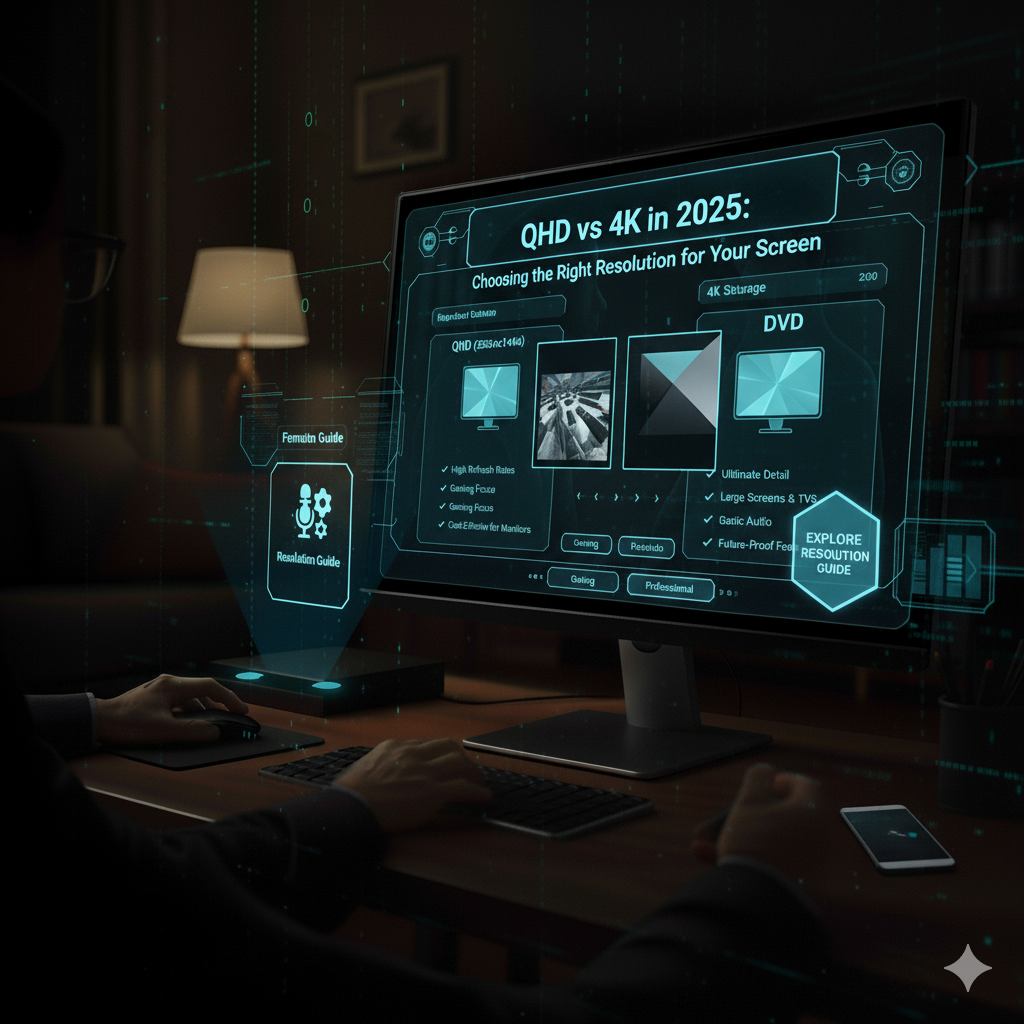When it comes to screen resolutions, two terms dominate modern display conversations, QHD and 4K. Whether you’re a gamer, designer, or movie enthusiast, choosing between these two can be confusing. Both offer sharp visuals, but they differ in pixel count, performance, and purpose.
In this article, we’ll dive deep into QHD vs 4K, exploring their differences, advantages, and the ideal use cases for each in 2025. By the end, you’ll know exactly which one suits your screen setup best.
Understanding Display Resolution
Before comparing, let’s quickly define what “resolution” means.
What Is Display Resolution?
Display resolution refers to the number of pixels a screen can display. Pixels are tiny dots of color that make up images on your monitor or TV. The more pixels, the sharper and more detailed the image appears.
For example:
- HD (720p): 1280 × 720 pixels
- Full HD (1080p): 1920 × 1080 pixels
- QHD (1440p): 2560 × 1440 pixels
- 4K (2160p): 3840 × 2160 pixels
Each jump in resolution means more pixels, higher clarity, and better image quality, but also greater demand on your device’s graphics power.
What Is QHD?
QHD stands for Quad High Definition. It offers four times the resolution of standard 720p HD and sits between Full HD and 4K in quality.
QHD Key Features
- Resolution: 2560 × 1440 pixels
- Aspect Ratio: 16:9
- Commonly Found On: Gaming monitors, mid-range laptops, and smartphones
- Pixel Density: Sharper than 1080p, smoother edges
QHD provides an excellent balance between performance and quality. It’s a favorite for gamers and professionals who want detailed visuals without overwhelming their hardware.
What Is 4K?
4K, also called Ultra High Definition (UHD), represents the next big leap in screen clarity. It delivers four times the resolution of Full HD and nearly double the pixel count of QHD.
4K Key Features
- Resolution: 3840 × 2160 pixels
- Aspect Ratio: 16:9
- Commonly Found On: TVs, high-end monitors, and premium laptops
- Pixel Density: Extremely sharp with lifelike detail
4K offers stunning realism, ideal for large displays, professional video editing, and immersive movie watching.
Image Quality Comparison
QHD Visual Quality
QHD screens look crisp and clear, especially on monitors under 32 inches. You’ll notice better text clarity and smoother graphics than on 1080p, but not quite the ultra-fine detail of 4K.
4K Visual Quality
4K takes clarity to another level. On larger screens, images look almost lifelike, perfect for watching high-definition content or working on 4K video editing projects. However, if your screen is small (below 27 inches), the human eye struggles to notice much difference from QHD.
In short:
- Small to medium screens → QHD is ideal
- Large screens or TVs → 4K delivers more visual depth
Performance and Hardware Requirements
The jump from QHD to 4K significantly increases your device’s workload.
QHD Performance
Running QHD requires moderate GPU and CPU power. Most mid-range graphics cards handle it smoothly, making it great for gaming or professional work without overheating or lag.
4K Performance
4K demands more, both in power and memory. Rendering twice the pixels means your graphics card, processor, and display port must be capable of handling higher data loads.
For example:
- Gamers: Need powerful GPUs like RTX 4070 or above
- Editors: Require strong CPUs and more RAM
- Streamers: Need high-speed internet for 4K playback
Gaming: QHD vs 4K
QHD for Gaming
QHD is often the sweet spot for gamers. It balances beautiful visuals with smoother frame rates. Most modern GPUs can run 1440p games at 120+ FPS with ease.
4K for Gaming
4K gaming is stunning but demanding. You’ll get incredibly sharp details, but performance may drop unless you have a high-end setup.
Recommendation:
If you prefer performance and speed, go with QHD.
If you prioritize visual quality and immersion, 4K is worth the investment.
Content Creation and Editing
QHD for Creators
For photo editors, QHD offers enough clarity for accurate color grading and detail work, without pushing hardware to its limits.
4K for Professionals
Video editors and digital artists benefit from 4K’s massive pixel density. It provides precise color accuracy and lets you edit content in native 4K resolution, essential for modern filmmaking and digital design.
Streaming and Entertainment
Streaming platforms like Netflix, Amazon Prime, and Disney+ now support 4K content, but bandwidth plays a big role.
- QHD streaming: Requires around 5,8 Mbps
- 4K streaming: Requires at least 25 Mbps
If you have limited internet speed or data caps, QHD streaming remains practical.
For best streaming results, check Netflix’s 4K streaming requirements and ensure your device supports UHD playback.
Future Trends: 2025 and Beyond
In 2025, display technology continues to evolve. QHD remains popular for performance-focused users, while 4K dominates high-end entertainment and creative industries.
We’re also seeing growth in 8K displays, but they’re still expensive and require extreme processing power. For most users, QHD or 4K remains the practical choice.
Internal Links (Mars IT Agency)
Explore more latest articles and guides on Mars IT Agency’s blog:
- Learn about 480p Resolutions in 2025, understanding low-resolution formats.
- Check Blu-ray vs DVD Comparison for physical media insights.
- Discover Top Discord Compressor Settings to optimize your audio experience.
External References
- Display Ninja: QHD vs 4K Explained
- Netflix Help Center – 4K Streaming Requirements
Conclusion
When it comes to QHD vs 4K, the right choice depends on your goals and hardware.
- Choose QHD if you value smooth performance, affordable pricing, and excellent image quality.
- Choose 4K if you want top-tier visuals, detailed content editing, and immersive movie experiences.
Both resolutions are excellent, but for most users in 2025, QHD delivers the perfect balance of clarity, performance, and value.
For more latest articles on technology, digital tools, and screen optimization, visit Mars IT Agency, your trusted source for modern digital insights.
